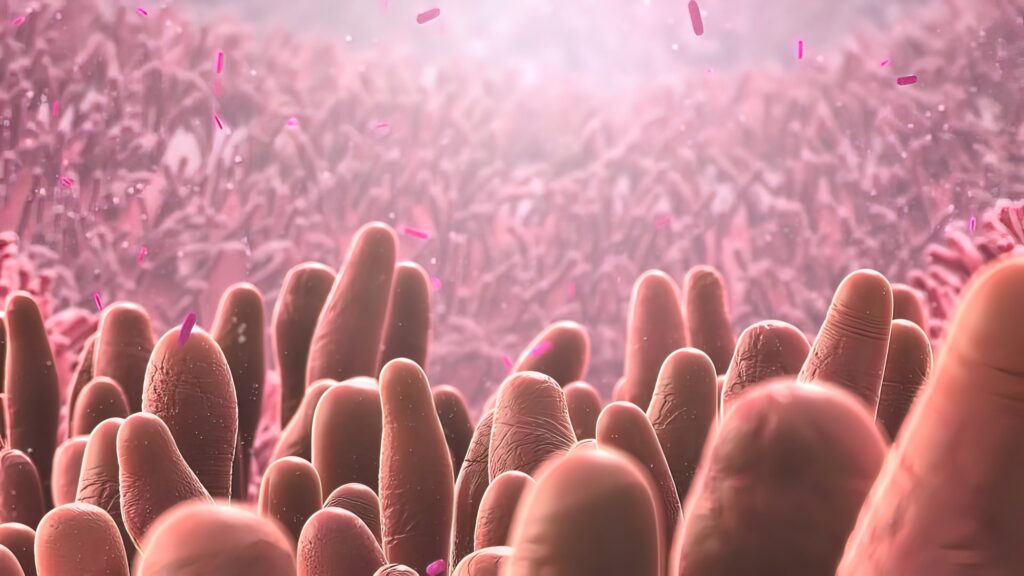Our gut flora has a role in many internal processes, including regulating our immune system, influencing our mood and cognitive function through the gut-brain axis, and influencing our metabolism and body weight. Not only are they essential to life, but the composition of our gut bugs is also a major indicator of our longevity and risk of chronic disease.
Found in probiotic supplements, Lactobacillus and Bifidobacterium are regarded as the superstars of the gut since their abundance is associated with better health outcomes and a lower risk of chronic diseases such as obesity, Alzheimer’s disease, type 2 diabetes, and cancer.
Yet, new research suggests that Akkermansia could play an important role in the composition of beneficial gut microorganisms.
What exactly is Akkermansia and how does it function?
Akkermansia muciniphila derives its name from its favorite food source, mucin, a glycoprotein that governs the thickness of our gut’s intestinal mucosal membrane.[1] As a result of consuming mucin, Akkermansia creates two short-chain fatty acids (SCFAs) – propionate and acetate – that feed other beneficial gut bacteria to produce butyrate, a SCFA that serves as an essential energy source for mucus-secreting goblet cells and intestinal epithelial cells. This is referred to as cross-feeding.
SCFAs strengthen tight junctions, which are the glue that holds our intestinal cells together. This keeps unwanted substances from getting through and into the bloodstream.
Imagine your gut lining to be a coffee filter that allows good things (coffee) in while keeping bad stuff (coffee grounds) out. In this sense, the “bad stuff” refers to allergens, endotoxins, fecal matter, and food particles, whereas the “good stuff” refers to macro and micronutrients from whole foods.
When bad stuff gets through, we have intestinal hyperpermeability, often known as “leaky gut,” which is the root cause of many chronic disorders. With a leaky gut, the immune system goes crazy and becomes hypersensitive, continually reacting to antigens (foreign proteins from food and bacteria) that enter the bloodstream unexpectedly.
Your intestinal epithelial cells are the only barrier between your immune system (and the rest of your body) and what’s happening in your gut. These cells can be harmed by a poor diet and lifestyle, antibiotics, and stress, which can lead to a leaky gut.
This is why Akkermansia may be a key indicator in the prevention and treatment of chronic diseases. Its SCFA metabolites nourish intestinal cells, thereby strengthening the gut barrier to prevent the passage of harmful substances. This results in the creation of anti-inflammatory chemicals and a reduction in inflammation.[2],[3],[4]
What’s the research?
Every day, we learn more about how Akkermansia operates. The majority of Akkermansia research has been conducted on animals, however, there have been several observational studies in humans that indicate that high levels of Akkermansia are also associated with favorable health outcomes including better metabolic health, gut function, and immunological health.[5] However, it is important to not draw definitive conclusions based on observational evidence because there are too many variables at play that can affect the outcome. Nonetheless, we are just scratching the surface of our understanding of this important bug, and more research is indeed needed.
However, this is very difficult because Akkermansia lives in a part of our gut that is not exposed to oxygen, so it can only survive in an oxygen-free environment (making it an obligative anaerobe) and dies when it is exposed to oxygen. Thus, outside of a lab setting, it is not feasible to culture and package to be used in supplements. Nevertheless, we know that Akkermansia can play an important role in preventing and treating chronic diseases, and the good news is that you can boost your levels organically with the power of real food!
How can you increase Akkermansia?
One of the greatest ways to naturally increase your levels is to consume an abundance of plant foods rich in prebiotic fibers and polyphenols, which feed and grow healthy gut flora.
Humans aren’t able to digest the prebiotic fibers found in plant foods, so the beneficial bacteria in our intestines do it for us. Having a fiber feast is good for them, and the SCFA gut-strengthening metabolites they create are good for us.
Polyphenols, the phytochemicals responsible for fruits and vegetables’ bright colors, are also found in plant foods. Polyphenols shield plants from predators and shield humans from illness by boosting the immune system and feeding the gut microbiota.
Additionally, colorful berries such as pomegranates, cranberries, raspberries, blackberries, and blueberries, and nuts such as walnuts and pecans contain polyphenol ellagic acid, which is a favorite food of the Akkermansia, as are the catechins and tannins found in green tea.5,[6],[7]
What’s the takeaway?
It is evident that Akkermansia is a vital component of the ecosystem of gut microbiota, serving to fortify the gut’s protective lining. A robust intestinal barrier is essential for maintaining gut health and is a cornerstone of wellness and the prevention and treatment of chronic disease. By nourishing your healthy gut flora, including Akkermansia, with plant-rich meals you are making meaningful strides in your health and longevity.
Several reports indicate that Akkermansia muciniphila affects glucose metabolism, lipid metabolism, and intestinal immunity, and that certain food ingredients such as fiber and polyphenols may increase the abundance of Akkermansia muciniphila in the gut. Products that SFI Health offers that contain these nutrients include TheraFlavone™ and SpectraFiber™.
References
- Hansson GC. Annu Rev Biochem. 2020;89:769-793. doi:10.1146/annurev-biochem-011520-105053
- Naito Y, Uchiyama K, Takagi T. J Clin Biochem Nutr. 2018;63(1):33-35. doi:10.3164/jcbn.18-57
- Zhang L, et. al. Pathog Dis. 2018;76(4):10.1093/femspd/fty028. doi:10.1093/femspd/fty028
- Bian X, Wu W, Yang L, et al. Front Microbiol. 2019;10:2259. Published 2019 Oct 1. doi:10.3389/fmicb.2019.02259
- Zhou K. J Funct Foods. 2017;33:194-201. doi:10.1016/j.jff.2017.03.045
- Evtyugin DD, Magina S, Evtuguin DV. Molecules. 2020;25(12):2745. Published 2020 Jun 13. doi:10.3390/molecules25122745
- Jeong HW, Kim JK, Kim AY, et al. J Med Food. 2020;23(8):841-851. doi:10.1089/jmf.2019.4662






